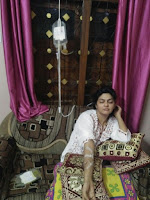Hemophilia and Social
Security Disability
“Not every Disability is
visible”
Hemophilia is a group of genetic disorders that affect the blood’s ability to clot normally. Those with hemophilia have to be careful to avoid situations in which they could be cut because they have a difficult time stopping bleeding once it starts.
Those with hemophilia don’t necessarily
bleed more severely than others, but they tend to bleed much longer because the
blood does not effectively clot. People with severe hemophilia can bleed for
several days – or even weeks – from cuts and scrapes that would be considered
minor for those without the disorder.
There is currently no cure for
hemophilia. It can be treated by factor replacement infusions, which medically
add the blood factors that aid in clotting and coagulation. Depending on the
type and severity of hemophilia, infusions may be given regularly or as needed.
Special exercises can also help prevent some effects of hemophilia.
Hemophilia is a chronic, genetic disorder in
which the body of the person affected is unable to clot blood. According to
Hemophilia Federation of India, one in every 10,000 Indians suffers from this
disease, making the estimated number of patients at least one lakh. It is
estimated that 90% sufferers in India can't afford treatment - the expensive
treatment burdens the whole family financially. There are many social issues
attached with Hemophilia patients, such as poor quality of life due to chronic
pain, frequent absenteeism due to bleeding episodes resulting in poor schooling
and poor employability, gender-related
issues due to victimization of mother or maternal guilt, economic consequences
due to high cost of treatment and the need to make out of pocket payment.
Persons with
Disabilities Act, 1995 does not include ‘Hemophilia’ under Disabilities Act.
Though the ‘Rights of Persons with Disabilities Bill, 2014’ was
introduced in Parliament (Rajya Sabha) to include, interiliac, Hemophilia
patients under the definition of ‘disability’, it is not making any headway.
Persons with Disabilities Act, 1995
The Persons with Disabilities Act (PWD), 1995
was the landmark legislation for the disabled in India. The Act defines
disability as blindness, low vision, leprosy-cured, hearing impairment, locomotors
disability, mental retardation and mental illness.
The Act calls for the government to take the
necessary steps to ensure prevention of disabilities and to make the general
environment non-discriminatory towards PWD by adapting and adding to railways,
buses, road signals, building ramps etc.
The Act contained many shortcomings. Hence, it
was proposed to be repealed as part of the Rights of Persons with Disabilities
Bill, 2014, which was introduced in Parliament (Rajya Sabha) on February 7, 2013
Salient Features the Rights of Persons with
Disabilities Bill, 2014
Disability is defined to include 19 conditions such as Autism; Low
vision and blindness; Cerebral palsy; Deafblindness; Hemophilia; Hearing impairment;
Leprosy; Intellectual disability; Mental illness; Muscular dystrophy; Multiple
sclerosis; Learning disability; Speech and language disability; Sickle cell
disease; Thalassemia; Chronic neurological conditions; Multiple
disabilities.
Rights of Persons with Disabilities
should be ensured
Education to the Children with
Disabilities should be ensured
Skill Development and Employment to
the Persons with Disabilities should be ensured.
Measures regarding Social Security,
Health, Rehabilitation and Recreation should be undertaken.
Special Provisions for Persons with
Benchmark Disabilities should be made.
Registration of Institutions for
Persons with Disabilities should be done and Grants should be provided to such
Institutions.
Establishment of National and State
Commissions For Persons with Disabilities.
Establishment
of Central and State Advisory Boards.
Haemophilia Treatment in England, USA and
India
ENGLAND
England provides free treatment to all patients
suffering from Hemophilia via the NHS (spell out), irrespective of their
economic status. It is a fully organized system which takes into account
different and specific needs of individuals. It is characterized by strong
patient participation. They follow the model of Comprehensive Care which
includes clinical services having doctors, nurses and physiotherapists with
specialization in Hematology; 24 hours laboratory services; investigation of
families of patients; advisory services to patient and family; regular review;
etc.
USA
In U.S.A, hemophilia care is delivered by highly
specialized federally designated Hemophilia Treatment Centers (HTCs), which
treat approximately 70% of people with the disorder. Pharmacy services are
essential to ensure timely and appropriate dosing of clotting factor agents, a
critical aspect of care for people with hemophilia. Services under the umbrella
of HTCs include - Coagulation Laboratory:
initial diagnosis and ongoing monitoring; Physician Services: Hematology,
pediatrics, and orthopedics; Nursing Services: education, anticipatory
guidance, home infusion teaching; Physical therapy; Nutrition; Dental services;
Social work /Social; Support; Research.
INDIA
In India, Hemophilia,
in particular, does not feature as a disability in the existing Act. India is
estimated to have the second-largest
number of patients suffering from hemophilia A, yet there is no specific relief
granted by the government for the patients, either in the treatment or
facilities to cope with other socio-economic situations.
Following steps need to
be considered:
·
At least
one hospital (or more, depending on the size and population of the State) in
every State is needed to provide services
for the betterment of Pwh
·
A National Program for Hemophilia, with
the suitable budget provision, is the
need of the hour. This would facilitate expansion of ‘One Country One Treatment’ program,
·
Programs
promoting self-infusion should be encouraged so that patients are well equipped
to take care of themselves.
·
The doctors
and nurses should be adequately trained for the treatment
of this disease, particularly in the technique of administering the anti-hemophilic
Factor concentrates
·
Schools
need to be equipped with facilities for students suffering from
Hemophilia. Also, no school should deny admission to a child on the basis
if this disorder.
·
There is an
urgent need for the government to organize awareness programs for the benefit
of patients and their families and educate them about ways of leading a
near normal life.
·
Hemophilia
puts the patients in a difficult scenario that proves to be a disadvantage
in the field of employment. There is a need
to ensure fair opportunities for
employment to such patients.
·
Hemophilia
should be included in the Disabilities Act, as proposed under ‘The Rights of Persons with Disabilities Bill,
2014’. This will help Hemophilia patients to avail the much-needed benefits from the schemes under
this Act.
I Stand For Disability Rights - Support US (19000 Hemophiliacs {Indians}) for
getting hemophilia into Benchmark Disability Act; as we also need accessibilty,
safety, community acceptance, Independent living and Quality of life; Full and
active participation in society; equal access to education and employment.
"Start by doing what’s necessary; then do what’s possible; and suddenly you are doing the impossible."
I Stand For Disability Rights - Support US (19000 Hemophiliacs {Indians}) for
getting hemophilia into Benchmark Disability Act; as we also need accessibilty,
safety, community acceptance, Independent living and Quality of life; Full and
active participation in society; equal access to education and employment.
"Start by doing what’s necessary; then do what’s possible; and suddenly you are doing the impossible."





Comments
Post a Comment